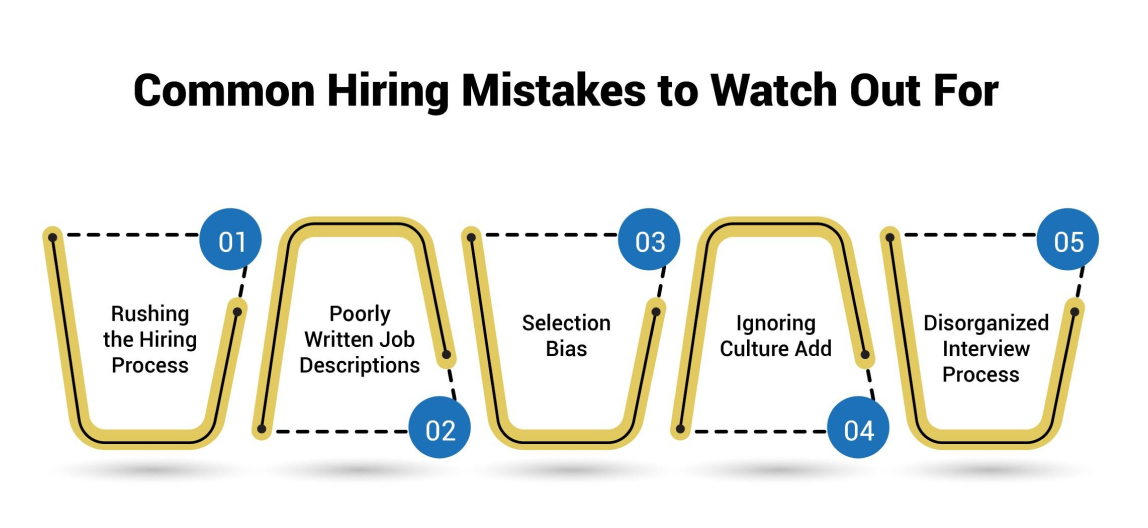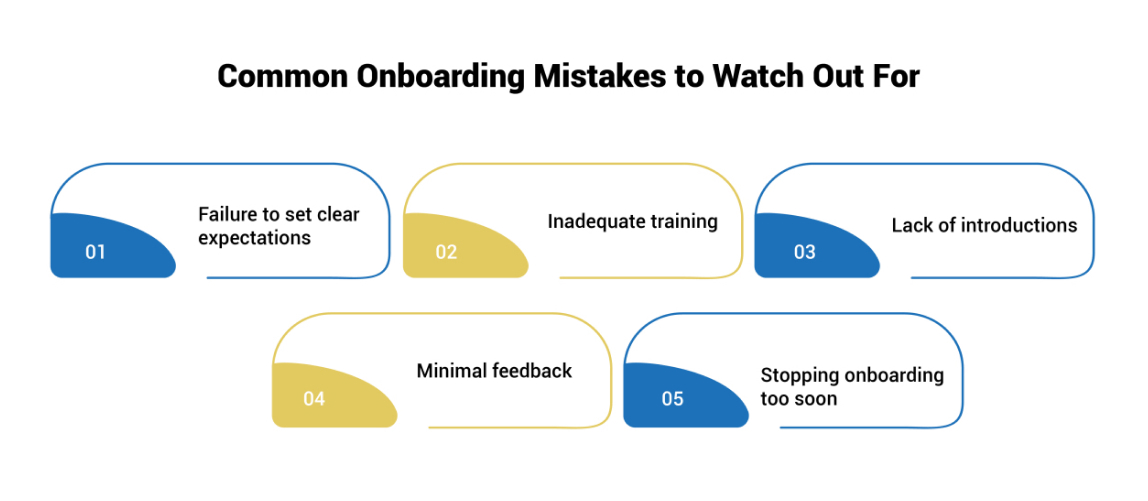
Hiring the right people and onboarding them effectively is crucial for building a productive, engaged workforce. However, even the most experienced HR leaders often fall into common traps that sabotage these critical processes. From writing poor job descriptions to neglecting employee onboarding check-ins, small oversights can have huge consequences.
The good news is that most hiring and onboarding mistakes are preventable if you know what to look out for. In this article, we’ll explore the most common pitfalls companies face when recruiting, selecting, and onboarding new hires. We’ll also provide actionable solutions to help you avoid these missteps so you can create seamless, effective hiring and onboarding experiences.
Hiring the right people and onboarding them properly are essential to an organization’s long-term success. Yet, many companies overlook just how costly—even small mistakes in these areas—can be, both financially and culturally. Investing the time and effort to get hiring and onboarding right yields substantial returns over time. Disastrous effects include:
Making the wrong hire can be hugely detrimental in terms of productivity, morale, and expenses. If a candidate seems perfect on paper but turns out to be a poor culture fit or lacks key competencies, they will likely underperform or leave quickly. This results in wasted time and money spent on recruitment and training, stalled productivity as teams cover gaps, and difficulty finding another qualified candidate. Rushing the hiring process or failing to thoroughly assess candidates' skills sets organizations up for making risky hires that undermine performance.
The downstream effects of a wrong hire or poor onboarding experience can substantially reduce team productivity. When roles stay vacant longer or employees struggle to get up to speed, teams must stretch themselves to cover gaps. Having roles filled by disengaged or incompetent employees also slows the entire team down.
People end up frustrated and burned out trying to compensate. If new hires have unclear expectations or inadequate training, everyone spends more time answering questions or fixing mistakes instead of pushing projects forward. This erodes morale and focus.
With today's competitive job market, organizations cannot afford to lose top performers due to preventable hiring errors or clumsy onboarding. When employees have a rough start due to inadequate support, confusing expectations, or role mismatches, they quickly become dissatisfied.
Many will simply leave for other opportunities rather than tolerate an unpleasant work environment. Without building engagement from day one through thoughtful onboarding, companies struggle to retain the talent they worked hard to attract. This makes maintaining productivity and momentum nearly impossible.
How an organization brings people on board also profoundly impacts its external reputation. With sites like Glassdoor and LinkedIn making it easy for candidates to share experiences, messy recruiting practices or chaotic onboarding gets noticed in the wider industry.
When people have a poor experience as applicants or new hires, they spread the word. This deters future talent and makes positions harder to fill. It also feeds public perception that the company lacks organization or doesn’t care about people.
A bad employer brand has long term consequences for attracting talent and makes hiring more expensive since companies must pay recruitment premiums to overcome negative perceptions.
From posting job listings to reviewing hundreds of applications and conducting endless interviews, the hiring process demands tremendous resources. When those efforts result in a bad match due to a flawed selection approach, all those wasted hours of staff time and candidate investment cannot be recovered. The same applies to onboarding time and expenses if the person leaves quickly.
Repeatedly cycling through the recruitment process to fill the same role over and over drains budgets fast. It also bogs down productivity as leaders and team members devote countless hours to activities that yield no return.
Lastly, disorganized hiring practices often result in losing top talent to the competition. When a hiring process drags on through too many interviews or lack of follow-through, the best applicants often pursue other options. They cannot afford to wait weeks or months hanging in limbo. Strong talent expects to be treated professionally and move forward in a timely manner. When hiring managers seem indifferent or make promises that get broken, candidates see red flags about how the company operates.
Rather than risk joining a disorganized culture, most take offers from other companies that make decisions faster. This leaves positions open longer or results in settling for weaker hires simply because recruiting dragged on too long chasing better ones away. Losing great candidates who would have been highly valuable is incredibly costly, both for immediate productivity and long term growth potential.
Many organizations make critical mistakes during these processes, leading to high turnover, low engagement, and decreased productivity. Avoiding these pitfalls ensures a smoother transition for new employees and a more successful long-term fit within the company.
To provide clarity, we have divided this section into two key areas:

Let’s start by examining some frequent mistakes made during the hiring and candidate selection stage:
1. Rushing the Hiring Process
Rushing to fill an open position without thoroughly vetting candidates is one of the biggest hiring mistakes companies make. The pressure to fill a role quickly leads many managers to take shortcuts, conduct rushed interviews without asking probing questions, neglect reference checks, and make snap hiring decisions based on limited data. However, this desire for speed often backfires. Hiring the wrong person is extremely costly in terms of lower productivity, missed objectives, and expenses related to termination, recruiting a replacement, and onboarding.
Here are some tips to avoid rushing the hiring process:
2. Poorly Written Job Descriptions
The job description is the foundation of your hiring process, dictating who applies, whom you interview, and ultimately who you hire. However, many job descriptions are hastily written by HR based on templates and generic job boards without input from the actual department leaders. This results in unrealistic, out-of-date, or too vague descriptions that attract the wrong candidates and lead to mismatched expectations. Here are some tips for crafting accurate job descriptions:
3. Selection Bias
Unconscious personal biases inevitably creep into the hiring process, causing managers to favor candidates most like themselves while overlooking strong diverse candidates with nontraditional backgrounds. This “similarity bias” limits diversity of thought and experience within the organization. Here are some strategies hiring teams can use to minimize selection bias:
Implementing unbiased, consistent, and skills-focused assessment practices minimizes inherent human selection biases to make hiring decisions more data-driven. Prioritizing diversity in both candidates and evaluators also enhances objectivity.
4. Ignoring Culture Add
It's tempting for hard-pressed managers to focus exclusively on technical competencies, prioritizing skills and knowledge above all else when reviewing resumes. However, while task-specific qualifications are undoubtedly crucial, soft skills and culture play equally vital roles in determining onboarding, long-term job success, engagement, and retention. Here are some strategies for assessing candidate cultural fit:
Rather than fixating on know-how alone, evaluating soft skills, emotional intelligence, curiosity, and values fit during interviews and work simulations ensures candidates not only have the right experience but also the relationship abilities to positively impact culture.
5. Disorganized Interview Process
A disjointed, inconsistent interview approach makes it impossible to accurately assess and compare candidates when each person meets different team members, gets dissimilar questions, and has divergent experiences. Here are some best practices for coordinating a streamlined interview process:
Implementing a structured, coordinated interview roadmap powered by consistent panel discussions, defined questions, and immediate debriefs allows you to gather rich insights on both skill qualifications and culture fit to make accurate hiring decisions.
Transitioning from hiring errors, let’s examine frequent onboarding missteps:

6. Failure to set clear expectations
Setting clear expectations from day one is crucial for new employee success, yet many companies fail to effectively communicate specific responsibilities, priorities, goals, and success metrics when onboarding. This leaves new hires without a solid understanding of what is expected of them in their roles.
To avoid this, managers should outline concrete onboarding plans that cover the first month, quarter, and longer-term expectations. Walk through key objectives and how they tie to broader company goals so new hires understand the bigger picture. Clearly explain not just individual but collaborative project ownership so they know both their specific tasks and how cross-functional efforts intersect. Share practical timelines and plans for the immediate period after onboarding wraps up.
Additionally, discuss exactly how performance will be measured by highlighting key quantifiable metrics and qualitative indicators of success. Revisit these early-stage expectations frequently as the employee ramps up to ensure alignment. Keeping responsibilities and priorities transparent from day one means no one is left guessing what “good” performance entails.
7. Inadequate training
Insufficient onboarding training inhibits new employees from reaching their full potential, even those with impressive credentials. Without structured guidance around internal processes, tools, and workflows, new hires lack context for translating existing skills into real impact.
First, acknowledge that everyone needs onboarding education and training to successfully integrate into a new organization. Then focus on building comprehensive programs that thoroughly cover company knowledge along with department and role-specific system mastery. Standardizing generalized components for consistency while allowing customization to address specialized needs or experience levels creates solid foundational knowledge for all hires while still providing personalized depth where advantageous.
Incorporate multifaceted learning opportunities through mentor pairings, temporary job shadowing, and online training modules to reinforce retention on top of formal presentations. Knowledge needs continual strengthening through practical activities that bridge information with application.
8. Lack of introductions
Failing to intentionally introduce new employees to organizational team members exacerbates innate feelings of anxiety and isolation. Without established connections, new hires lack critical context for collaboration and relationship building that facilitate success.
Humanize the onboarding experience by proactively establishing connections between new staff and essential colleagues from various divisions right from day one. Arrange peer buddy assignments to foster more casual advice/information sharing. Coordinate team lunches to put names to faces in a relaxed environment. Promote virtual introductions and collaborations for remote hires.
Provide new employees with opportunities to organically expand professional relationships by collaborating on cross-functional projects where expertise overlaps. The more positive interactions cultivated early on, the quicker new employees develop the working relationships imperative for making cooperative impact on organizational goals.
9. Minimal feedback
Despite initial training and introductions, many companies provide little proactive feedback once formal onboarding ends. This wrongly assumes new employees will speak up with questions unprompted. However, discomfort asking “stupid” questions, pride, introversion, and other barriers often prevent them from pursuing the guidance they need.
Combat this avoidance by officially scheduling 30, 60 and 90-day conversations to mutually share feedback without judgment. Discuss areas going smoothly alongside places where more support resources or training would be beneficial. Convey that speaking up with questions or seeking help is encouraged rather than being perceived as bothersome or incompetent.
Reinforce an open-door culture for continually sharing feedback in both directions, which is especially critical for hybrid teams with less built-in visibility. Frequent check-ins demonstrate investment in the individual while benefiting the organization through better identification of knowledge gaps, process issues, and mentoring needs.
10. Stopping onboarding too soon
While onboarding often focuses on equipment setup, paperwork, and bootcamp-style training, assimilating into organizational culture and processes is an ongoing endeavor. Curtailing onboarding activities immediately after initial weeks or training wraps leaves new employees underprepared despite seeming “trained.”
Set the expectation that onboarding lasts through the first year with structured activities tapering gradually over months instead of disappearing abruptly. Use 30, 60 and 90-day milestones to assess progress rather than as end points. Encourage ongoing formal and peer learning opportunities. Seek regular feedback on challenges employees still face. Offer extended introductory periods for certain systems. Connect new staff with networks like ERGs and mentors that support longer-term success.
Track metrics like competency acquisition, productivity, and cultural integration alongside duration to better grasp when onboarding objectives are truly achieved for each new hire. An investment mindset around onboarding prevents organizations from ending support prematurely at the expense of talent retention and performance.
In today’s hypercompetitive economy, hiring and onboarding missteps carry tremendous financial penalties and talent opportunity costs. However, armed with awareness of the most common mistakes, HR leaders can deliberately improve their organization’s processes to attract, develop, and retain ideal talent.
Avoid knee-jerk hiring calls. Emphasize culture fit and soft skills. Onboard gradually using structured support systems. By sidestepping these pitfalls, you’ll notice more top candidates joining and thriving within your exceptional organization.